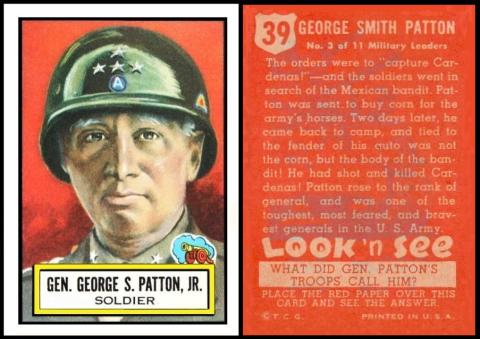
This card may have surprised a few of our readers who do not know the story of the Academy Awards, but it celebrates the first time an actor refused to accept one. That was George C. Scott, who played our man, George Smith Patton in the film of his life, called simply "Patton", released in 1970. In fact, Mr. Scott initially refused the nomination, as he had done in 1962 for "The Hustler", because he did not feel comfortable being compared to other actors. In that year he did not win so it was of no import. However in 1970 he did win, and he did not back down. The film`s producer collected the award on his behalf and it was given to the Virginia Military Institute.
Now Mr. Scott may have been the first actor to refuse, but he was not the first person to. In 1935 Mr. Dudley Nichols, the screenwriter of the film "The Informer" did, citing the preferential treatment of the Screen Playwright`s Guild over his organisation the Screen Writer`s Guild.
This set is often cited as one of the favourites of all time. Perhaps that has something to do with the stunning artwork, or maybe it is just one that most of today`s collectors remember collecting when they were children. By the way we only know the year, or rather the earliest it was issued, from card 104, which shows Queen Elizabeth II, for she was crowned in February 1952. The cards are undated.
There are a hundred and thirty five cards in the set, but it was actually issued in two parts, the first batch being numbers 1-75 and the second being the remaining sixty cards. Nobody seems to know why they did not have two groups of seventy-five, making a more even total of a hundred and fifty. There is a bit of a downer though, because it is very hard to get one that looks like ours, with almost square borders. Most of them are out of square to one side or the other, with one slim to non-existent border, and one huge one and this does affect the value, though in years to come we may find this matters less.
Before we race on, did you know that this large set is split into groups? Well have a look along the top edge of the box that holds the subject`s name and you will see a small cartoon style picture. In this case it is a cannon, for the military. The card of Billy the Kid has a covered wagon, for the Wild West, and for some reason the most sought after card of all, Babe Ruth, has a shield.
Something else you may not have noticed is that the backs actually have a drawing on them, a kind of watermark under the text. This is often very faint but on our card you can fairly clearly see it is a tank, surprisingly, as these red backs are almost impossible to scan and keep the wording legible. There was a point to them though as in each pack there was “A Decoder” and this tool was used to reveal the trivia answer on the card. It was actually just a red strip of cellophane, but it worked, in a fashion, and it certainly worked better because of its scientific/espionage related name, especially if you think of what America was like in the 1950s…One thing I would love to know is how the "red paper" decoder worked. This was a piece of red cellophane which you put on the back of the card and it magically told you the answer to the question on each card. The only slight problem is that the cards do not actually call it “A Decoder” they just say “the red paper”.
By the way the most sought after card in the set is Babe Ruth, the only baseball player and actually the only sportsman. There is a bit of a rumour that Rembrandt (number 82) is a key card, and that either he was printed separately as a very short run, or that his cards were somehow held back. I am not sure of these theories, for surely doing this to a more prominent American would have had a bigger impact. And just imagine if they had selected Babe Ruth ...
